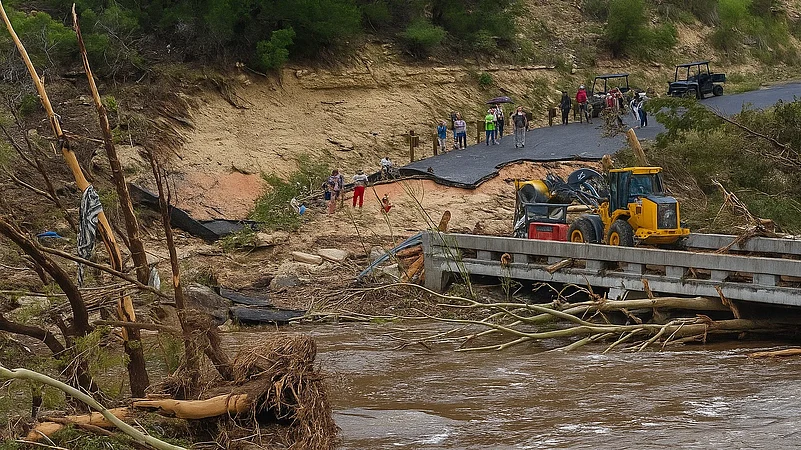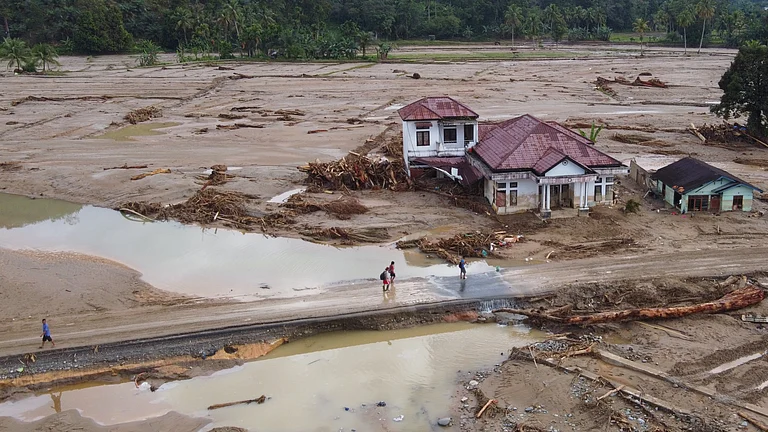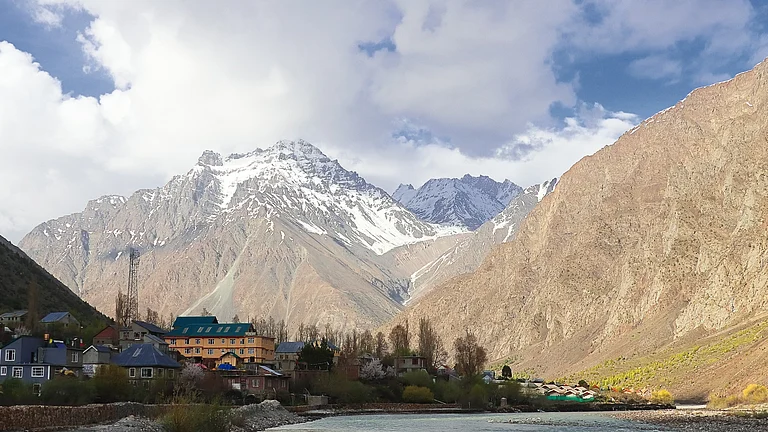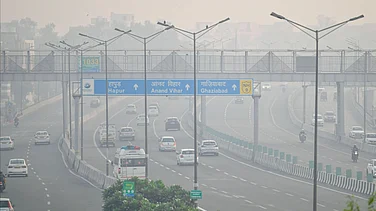A destructive cloudburst swept through Uttarkashi's Dharali village on August 5, triggering flash floods that claimed five lives, while leaving 60 missing, according to reports.
The nature’s fury that swept through the high-altitude region not only took people, who had gathered for the annual Har Dudh fair in the village, away with it but also destroyed several houses, shops, homestays, hotels, trees, cars, and roads, burying nearly half the village under a torrent of mud, rubble and water as rescue teams struggled to carry out operations in the Himalayan terrain.
But this is not an isolated event this year, restricted by either time or space.
From deep in the Himalayas to the rough, hilly terrain of central Texas, regions around the world have seen a raft of flash floods this past month that have left death and destruction in their wake.
Unfortunately, officials at Nepal's Flood Forecasting Division under the Department of Hydrology and Meteorology didn’t see the flood coming in the Bhotekoshi river until 6 am on the morning of July 8. As reported by The Kathmandu Post, Trishuli river basin underwent devastation due to this lack of cross-border communication mechanism for climate events. The Flood Forecasting Division came to know about the flood only after it reached Betrawati, the border between Rasuwa and Nuwakot districts.
By July 9, the floods in Nepal claimed at least 8 lives, while 19 were reported missing (11 Nepali nationals, including two police and six Chinese nationals) in the flood, Nepal Police told The Kathmandu Post.
Halfway around the world, on July 4, flash floods inundated large parts of central Texas to claim at least 110 lives, while more than 160 people went missing after the devastating floods, according to NBC News.
Closer home in India, Himachal Pradesh, too, has been reeling under the wrath of endless heavy rainfall and cloudbursts that caused about 85 deaths since June 20. About 54 people lost their lives in the region due to rain-related disasters like cloudbursts, flash floods and drowning incidents, according to ANI. The state has also witnessed consequent damage to life, property, livestock and infrastructure.
The disaster, though separated by time and space, points to a few common underlying factors that include extreme and erratic rainfall patterns, unique geographical features, and the devastating effects of climate change on vulnerable regions. From Texas to Nepal, a lack of proper weather monitoring and information sharing systems indicate the heightened need for robust preparation from the government apart from highlighting the critical need for early warning systems.

Considering the devastative floods in Texas, climate change has once again become the centre of conversations. According to ClimaMeter, the extreme weather conditions preceding the floods, delivering more than double the typical monthly rainfall in just one day, indicated a cause beyond natural climate fluctuations.
Located in one of the world’s most vulnerable regions to climate crisis, Nepal had witnessed extreme weather events over the past decade and a half. However, experts say that extreme weather events such as dry spells, droughts, below average precipitation, heavy rainfall in a short period, rains beyond the monsoon season, above-normal winter temperatures, have become more frequent in the country.
The Himalayan region, where Himachal Pradesh also lies, is particularly vulnerable because of its complex topography. According to a 2021 study published by the University of Leeds, Himalayan glaciers are melting rapidly—losing up to 40% of their area, and shrinking from a peak of 28,000 km2 to around 19,600 km2 in 2021.
Citing a note released by the Central Water Commission on the evening of August 5, HT reported that a series of suspected cloudbursts occurred in quick succession that day in Dharali village, located in the Uttarkashi district of Uttarakhand.
Dharali is within the fragile Bhagirathi eco-sensitive (ESZ). Experts believe that unregulated activities like construction on river floodplains could be among the factors contributing to the intensity of the disaster.
The first cloudburst reportedly took place in Dharali, near Harshil, around 1:00 pm. The second incident occurred between Harshil and Gangnani (near Sukki Top), around 3:00 pm, followed by a third incident near the Army Camp, Harshil at around 3:30 pm, reported HT.
The immense destruction caused by these events emphasises the urgent need to understand and address the underlying factors behind their increasing frequency and severity.
What are Flash Floods?
According to US National Weather Service, a flash flood is caused by heavy or excessive rainfall in a short period of time, generally less than 6 hours. Flash floods are usually characterised by violent torrents followed by heavy rains that rip through river beds, urban streets or mountain canyons.
They are expected to occur within minutes or a few hours of excessive rainfall. They can also occur even if no rain has fallen for instance after a levee breaks or a dam has failed, or after a sudden release of water by a debris or ice jam.
Contributing Factors
Extreme rainfall and severe flooding caused due to climate change pose challenges for policymakers as they threaten to overwhelm flood defences.
While the events strongly suggest cloudbursts as the trigger, some experts have also pointed to unregulated construction in the fragile zone as a potential cause.
The Bhagirathi Eco-Sensitive Zone is a 4179.59 sq km watershed area along the stretch of Bhagirathi river between Gaumukh and Uttarkashi town. It was notified in 2012 by the Ministry of Environment, Forest and Climate Change (MoEFCC) under the provisions of the Environment (Protection) Act, 1986 to protect the Ganga river’s upper watershed and ecology. The Bhagirathi river is one of the main headstreams of the Ganga, joining with the Alaknanda river at Devprayag to form the Ganga river.
ESZs are ecologically significant areas intended to be protected from unregulated development and industrial pollution, as per the Environment Protection Act of 1986.
Despite such protective measures, the region drew attention in recent years due to construction of the Centre’s flagship initiative of Char Dham all-weather highway project which proposed widening of 889 km of mountainous road to provide all-weather connectivity to Uttarakhand’s Char Dham shrines. The project faced legal challenges due to ecological concerns, but was eventually cleared by the Supreme Court.
According to Down to Earth, this year’s monsoon rains have caused deadly damage on the Indian side of Himalayas, with Himachal Pradesh witnessing the worst impacts over the past few weeks.
Scientists have long attributed soaring temperatures as the cause of more extreme events such as torrential rainfall and floods across the world, including Texas Hill Country.
According to The World Meteorological Organization, warmer air can hold more water vapour—for every one degree Celsius rise in average temperature, the atmosphere can hold about 7% more moisture. This makes storms more likely to produce higher intensity, frequent and long-lasting precipitation, which eventually causes severe flooding.
According to The Indian Express, the Texas flash floods likely unleashed due to a warmer than usual water of the Gulf of Mexico that could have contributed to extreme rainfall. Higher sea surface temperatures lead to more evaporation and moisture transport to the atmosphere, which ultimately results in an increase in rainfall.
Meanwhile, the flash flood in Nepal’s Bhotekoshi River along its border with China is attributed to heavy rainfall on the Chinese side and extensive damaged infrastructure in the Timure area on the Nepali side. According to Mint, the cause of the flash flood is still under investigation. However, the heavy rainfall in the Tibetan region may have triggered the surge but the exact reason has not yet been confirmed. The News Himachal too underscored that experts attribute Himachal Pradesh’s increasing instances of such events to both climate change and unregulated construction in ecologically fragile zones, resulting in more intense, unmanageable cloudbursts and other extreme weather events.
According to a study published in the journal Nature, flooding causes devastating impacts worldwide. The report states that global damages from such natural disasters amounted to an estimated $651 billion and affected 1.6 billion people between 2000 and 2019 alone. The report indicated that the losses from these events could increase by a factor of 20 by the end of the 21st century.
Understanding and mitigating future natural hazards is a critical imperative given the erratic nature of weather patterns due to climate change.



































